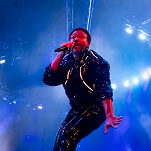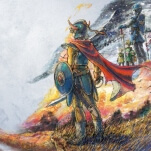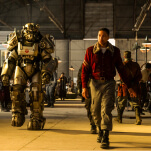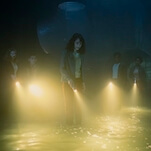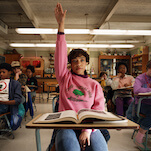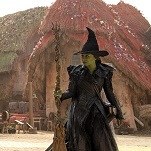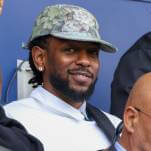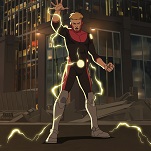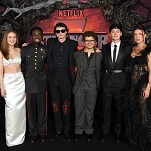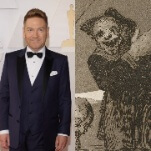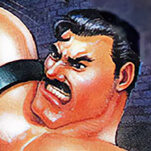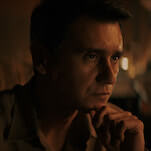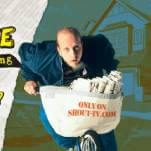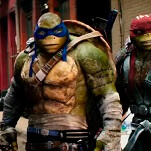I doubt this new first issue will change that. It looks good and the story zips along as a humbled Jordan tries unsuccessfully to continue his work as a hero without a Green Lantern ring and Sinestro reluctantly takes the Green Lantern oath. And Sinestro is my favorite sort of villain: a bad guy who doesn’t think he’s a bad guy. But otherwise it feels like more of the same. I’ll probably stick with it for a while and then drift away, but maybe future issues will surprise me.
When Detective Maggie Sawyer asks Kate out on a date, the panel goes black-and-white as Kate looks at a picture of her ex-girlfriend Renee Montoya on the wall, the only color appearing in Renee’s face. In that moment we are inside Kate’s head, watching her struggle with the memories that hold her back and keep the color out of her world. The color returns as she agrees to Maggie’s proposal in the next panel, and the image tightens on the two women to cut Renee out of frame. It doesn’t matter if it’s a quiet emotional moment or an action-packed double-page spread—Williams is going to execute it thoughtfully and unpredictably. And having him as a writer means complete creative synergy between the script and art.
Frankenstein, Agent Of S.H.A.D.E. #1
KP: Running with the version of Frankenstein’s monster introduced in Grant Morrison’s Seven Soldiers, the hero of Frankenstein, Agent Of S.H.A.D.E. is a soulful brute of a reanimated corpse. A sword-wielding monster filled with the romantic spirit of the age in which Mary Shelley created him, he battles monsters for the covert ops agency S.H.A.D.E. (“Super Human Advanced Defense Executive”), where he works with both his “father” (who, we discover here, has transferred his consciousness into the body of a pigtailed little girl) and Ray Palmer (who may or may not be The Atom now, but uses Atom-like technology to reduce S.H.A.D.E.’s headquarters to microscopic size). The implications of the experiments around him trouble Frankenstein (who’s apparently just taken the name of his creator as his own), but this first issue finds him swallowing his reservations in an attempt to rescue his wife from a town overrun by monsters. Helping him out: a team of new S.H.A.D.E. recruits who bear an uncanny resemblance to other famous movie monsters.
I loved this issue, which combines humor, over-the-top action—strikingly realized by Italian artist Alberto Ponticelli—the sort of big, crazy concepts that comics can realize better than any other medium and, courtesy of its hero, a soulful center. Sweet Tooth and Essex County writer Jeff Lemire delivered one of the best books of the relaunch’s first week with Animal Man. He tops himself here, seamlessly integrating a lot of exposition into a story that never stops moving, and Ponticelli’s rough-edged style suits the material. He’s good at realizing both sweeping battle scenes and small moments, as when Frankenstein hunches over the tiny figure of his “father,” holding a sword and making a threatening expression but still looking powerless. “This place is an advertisement for mad science about to go wrong,” Palmer says to his teammates at one point. Here’s hoping it keeps going wrong in ways as right as this.
OS: Lemire has quickly shot to the top of the DC pantheon of writers after his two relaunch titles. Frankenstein is completely different in tone than Animal Man, yet follows the same guidelines: establish the character, what his place is in the world, and what makes him interesting. The combination of high-concept sci-fi and classic monster movies centered on Morrison’s hyper-romantic Frankenstein is inspired, and incorporating Ray Palmer is a smart way to bring the book into the larger DCU. Unlike Eric Wallace in Mr. Terrific, Lemire introduces a plethora of ideas, but uses the narration to provide details that enrich the world and make everything just a little bit more plausible. Is it necessary to know that the automaton Hominids are a renewable energy source for S.H.A.D.E. HQ after they decompose? No, but it’s the kind of detail that shows how deep Lemire’s plotting goes. Alberto Ponticelli created a bleak, occasionally grotesque view of Africa in Unknown Soldier, and he’s the perfect fit for this book. It actually reminds me of Jeff Lemire’s art but with a bit of a Paul Pope influence. Also, that’s not Dr. Frankenstein in the little girl body; it’s Father Time, the S.H.A.D.E. equivalent of Nick Fury.
Demon Knights #1
OS: This is the Paul Cornell I’ve been waiting to see. Cornell does his best work when he’s playing with Arthurian legend and British folklore, and Demon Knights, a medieval Magnificent Seven, has an appropriately epic feel while retaining the writer’s sense of humor. Incorporating elements from basically any DC comic involving Arthurian legend in the last five years, Cornell brings characters like Etrigan the Demon and Vandal Savage together in a war against the imperialistic Questing Queen and Mordred, King Arthur’s evil son. These aren’t superheroes, but fantasy characters in the Dungeons & Dragons vein: wizards, knights, and demons that fight barbarians and knife-wielding dinosaur-dragons. The connections to Grant Morrison’s Seven Soldiers and Matt Wagner’s Madame Xanadu Vertigo series makes the book feel like part of a larger universe rather than an isolated story set in the past, and a panel in Stormwatch last week suggests that Cornell is planning to keep his two books connected. That can only mean good things for Stormwatch, because Demon Knights #1 is one of the strongest launches so far.
Diogenes Neves has done solid work on New Mutants and Green Arrow, but his art flourishes in the medieval setting. There is a tinge of manga styling, but I think it works for the fantasy genre. The action sequences are dynamically choreographed, but Neves also does great work on the lighter moments, showing particular affinity for Madame Xanadu. When “Jason o’ the Blood” transforms into Etrigan, the Demon grabs Xanadu and the two share a passionate kiss. When they pull away from each other, billows of smoke flow from their mouths. Visual flourishes like that give life to the world. Hopefully Cornell’s bad luck keeping new books afloat at Marvel doesn’t follow him to DC, because this team may have the start of a bona fide DC fantasy epic.
KP: Cornell’s Knight And Squire miniseries—a story of an English Batman and his sidekick that starts as a lighthearted tweaking of Englishness and then develops into a darker examination of how national traits like irony and self-deprecation can be virtues—was one of my favorite books of the last year or so, and this series looks like it’s going to play to his strengths in a big way. If it works, it lets DC tell big, comic book-y stories in a setting and genre that readers generally don’t look to for them. Cornell has a really nice sense of how to balance humor with gravitas (which makes sense for a veteran of Doctor Who), and that’s rare. A lot of the books we’ve looked at provide solid, somber set-ups. (Take Resurrection Man as one example.) Not that all the books have to be fun. But I’m excited to encounter one that really does look fun.
Batman And Robin #1
OS: This is the kind of Batman story I like to read: an actual mystery with an emotional hook. This is another book picking up pre-Flashpoint story points, with Peter J. Tomasi and Patrick Gleason continuing their Batman And Robin run, but with Bruce Wayne back behind the cowl instead of Dick Grayson. After a short-but-brutal scene with the Batman of Russia getting attacked, the issue shifts to Gotham, where Bruce Wayne is acclimating to having his son Damian as the new Robin. He’s decided to make some changes in his life to make it a little less dreary, beginning with a schedule change. On the anniversary of his parents’ deaths, Bruce takes his son to where his grandparents were gunned down. It’s Damian’s first and last visit, as Bruce decides that in the future he will remember his parents’ lives on their wedding day, but Damian doesn’t give a shit either way. His father’s nostalgic affection is irrational to Damian, who only gets satisfaction through violence. Bruce is sentimental, Damian is sociopathic, and they’re both completely stubborn. Batman gains a Robin with exceptional skills and no fear, but Damian’s lack of self-restraint makes him just as deadly as the criminals. It’s a great dynamic that I hope gets as much attention as the action.
I’ve been a fan of Patrick Gleason’s for a while, and he continues to grow with each project. On Green Lantern Corps he showed his impressive talent for character design and world-building, and his Batman And Robin art is all about establishing atmosphere. The first half of the book is covered in shadows, emphasizing Bruce’s solemn mood, but once the duo leaps into action, the book brightens up for a spectacular action sequence set in a nuclear facility underneath a swimming pool. Damian’s character comes out when he’s fighting, and Gleason has him taking out the thugs in a delighted frenzy, smiling as he watches them all burn up in a ball of nuclear fuel. Damian Wayne has been a controversial character since his introduction, but I’ve grown to like the little brat. How about you, Keith?
KP: Oh, definitely. I was a little worried Damian wouldn’t make it through to the other side of Flashpoint. Giving Batman a son is one of those terrible-seeming ideas that’s paid off brilliantly for the Batman titles. I was a little worried if anyone else would be able to write for him, but I liked Tomasi and Gleason’s post-Morrison, pre-reboot issues, and I like this one too. Their Damian, like Morrison’s, is sociopathic, but also very much a little kid. And thus redeemable. Maybe. That’s what makes the character so fascinating. I loved the rapport between Damian and Dick Grayson, but the Bruce/Damian pairing brings different responsibilities. Bruce had barely gotten to know the kid when he got disappeared in time for a while. Now he has to be a dad. And a masked avenger. And a mentor. Plus this story has a mystery that needs solving and no full-page images of the Joker’s peeled-off face. (Sorry to harp on that.)
Superboy #1
KP: Superboy used to be the name used by Superman as, naturally, a boy growing up in Smallville. That changed in the early ’90s when, after all the Superboy history got wiped out by Crisis, Conner Kent took on the name. Born in a lab from the cloned DNA of Superman and Lex Luthor, Conner was always a potentially tragic figure, tortured by his past and unsure of his place in the world. He grew up in Smallville, raised by Clark Kent’s own adoptive parents, but any goodness in him seemed more taught than innate.
This new Superboy, written by Scott Lobdell and drawn by R.B. Silva, keeps some of that history. We still have a Superboy grown in the lab, and it’s hinted that the non-Superman half of his genetic make-up comes from Lex Luthor. He has a comfortable life in small-town Kansas, but it’s all a computer simulation and he knows it. He’s a head in a jar who knows he’s a head in a jar, in other words. Outside the jar, he has a sympathetic scientist he knows only as “Red” (who’s likely a character from the Wildstorm title Gen 13) on his side and Rose Wilson working some agenda that may or may not be to his benefit.
I have mixed feelings about this one. I like Silva’s art and the portions told from Superboy’s extremely limited point of view are pretty effective. But the ending feels rushed and confusing, and not in a way that left me particularly intrigued, even if we do apparently get a first look at the new Teen Titans. Even that left me more confused than intrigued, though. Is Wonder Girl a Napoleonic sea captain now?
OS: I liked this book more than I expected it to, although it became tiresome after the Smallville red herring, then picked up again at the last page. A guy in a tube commenting on the world around him just isn’t all that interesting, but Lobdell does a fine job with Superboy’s inner monologue. I don’t see any point in building up the mystery of Superboy’s human DNA donor if it’s just going to be Lex Luthor, and hopefully Lobdell has some tricks up his sleeve. Silva landed on my radar after the outstanding Jimmy Olsen Special, but this issue doesn’t really give him much opportunity to stretch his imagination. I wish he were the artist on Teen Titans after seeing the last page; he needs a book wider in scope to show off his design skills, and this issue doesn’t give much idea about what the future of Superboy will look like.
[pagebreak]
Mister Terrific #1
KP: Accessibility has been one of the watchwords for the New 52, snaring new and lapsed readers being one of the initiative’s goals. But, apart from Justice League, I think this is the first issue I’ve read with an honest-to-goodness origin story. (Though I’m guessing there may be more further down the stack.) Mister Terrific needs it. Though the character’s been around since the 1940s, he’s never been hugely popular. I always liked Michael Holt, the second Mister Terrific, in JSA, with his tragic background, his corny-but-awesome “Fair Play” motto, and his history as an Olympian and a scientific genius. (He’s frequently referred to as the “third smartest man in the world,” which I always assumed put him behind Lex Luthor and Bruce Wayne, but has that ever been confirmed, Oliver?) And, it has to be noted that, as a black hero, he gives the DC Universe some much-needed diversity.
I had mixed feelings about this first issue. It starts off well with an adventure in London and some sprightly dialogue. (“A simple ‘Thanks, black guy, for saving us from a homicidal lunatic wearing weaponized body armor’ will do,” he tells some people he’s rescued when they pepper him with questions.) And, even if all his women have elfish eyes, Gianluca Gugliotta’s art is appealing, if not terribly groundbreaking. But I flashed on the Bechdel Test when two supporting female characters—one of them Karen Starr, a.k.a. Power Girl—meet and immediately square off against each other in a racially charged confrontation simply because they’re both women in the life of our hero. We’ve barely met them and this is how they’re being defined? Otherwise, this felt like a decent first chapter in a story that will have to get more gripping to stand out from the pack of 52. (Not sure the tattoos fit the character, either.)
OS: I believe the rules state that if a character’s costume lacks a collar, he must have tattoos. Eric Wallace is very much in the J.T. Krul camp for me after they both contributed to the demise of Roy Harper’s character last year, and while this is a step up from his dreadful Titans, he’s definitely trying the see-what-sticks style of storytelling. A lot of ideas are thrown around this issue, and while denouncers of decompression will appreciate the packed story, it reads like Wallace is in a rush. I didn’t care for the dialogue, especially when race would suddenly enter the picture. I didn’t find the line you mentioned sprightly, I thought it was clunky and out of place. Superman would never tell someone that a “Thanks, white guy” will suffice; it’s belittling. I know that this is a bold reinvention of the character or whatever, but the Michael Holt I’m accustomed to has more self-respect than that. I agree with you about the depiction of females in this book, and that scene elicited a bigger groan out of me than Joker getting his face nailed to a wall last week.
Grifter #1
KP: I’m just excited that this book is being drawn by former Brazilian soccer star Cafu. Oh wait. Apparently this is CAFU, another single-named, but all-capitalized person. Or is that a collective? I’m pretty sure it’s a person. Either way, I liked CAFU’s work here. It’s clear and dynamic, even if he (he, right?) apparently has no idea what cemeteries look like in New Orleans. And I suspect I might like the story if I had a bit more of it to judge. Grifter is another transplant from the Wildstorm universe. Outside of his role in the Ed Brubaker-penned miniseries Point Blank, I’m not too familiar with him, but that doesn’t seem like a requirement here—best I can tell, the book is hitting the reset button on the character. What it’s going for, however, I don’t know. The plot’s a mix of con artistry and aliens that frankly left me a little lost. Future issues might correct that. It reads like a book that could turn into something, but as a jumping-on point, this didn’t really work for me.
OS: This was the surprise book for me this week, a solid action thriller with a sci-fi twist. I was confused, but it was the kind of intrigued confusion that comes at the start of a good mystery. I’m not familiar with Nathan Edmondson’s work, but this is one of the better-paced issues of the relaunch, emphasizing the solitary nature of Cole Cash’s lifestyle and the chaos that ensues after he escapes from an alien experiment. CAFU’s T.H.U.N.D.E.R. Agents was a huge surprise for me, and I’m excited to see him on a story that has a similarly suspenseful tone. I’m a sucker for incorporating the story title in the artwork a la Will Eisner, and after the intense action opener, seeing “Grifter: 17 Minutes” as shelf decoration helps the tone shift to a more crime noir style of storytelling. I will definitely be sticking around for the opening arc, which is something I never thought I’d say about a Grifter book.
Resurrection Man #1
OS: I’m not sure who was clamoring for the return of Resurrection Man, but here he is, with original writers Dan Abnett and Andy Lanning (DnA) back at the helm. After being a guinea pig in nanotechnology experiments done by an organization called “The Lab,” lawyer Mitch Shelley became immortal. He can die, but he resurrects shortly after with a new superpower connected to the way that he was killed. The concept is inventive and offers a lot of story opportunities, and I enjoyed the issue until the angel stuff started happening. Mitch resurrects at the start of the issue, then quickly finds himself in the middle of a war between heaven and hell for his soul, taking the book in a direction that feels a bit like a retread of the last few years of Ghost Rider stories. Fernando Dagnino’s art creates a creepy horror atmosphere, but this book needs substance to match the style. Who is Mitch Shelley, and why do I care about him? Mitch has no personality, no supporting cast, no real character traits other than not being able to die properly. With the plot set-up out of the way, hopefully DnA will start the character set-up; I’m willing to give this book a chance just because it’s so different from the typical superhero book.
KP: Me too. I’m new to DnA, so I didn’t really know what to expect. I’d also never read anything with Resurrection Man before—in my defense, who has?—and this one left me curious as to what would happen next. But, as you point out, it’s going to have to give us reasons to care beyond the central mystery, and soon, if it wants to stay intriguing.
Suicide Squad #1
KP: The Suicide Squad, as it’s been around since the ’80s, has a pretty irresistible hook: What if the good guys assembled a bunch of bad guys to work as a Dirty Dozen-like superteam and do the dirty work traditional heroes would never touch (or want to know about)? This revived version has kept that hook and uses a novel, if grim, device to introduce the team. We meet each member one-by-one as they’re being tortured into giving up the name of the boss who assembled their team. That’s Amanda Waller, the intelligence chief (I guess that’s the right term) behind Suicide Squad, who here has been transformed from a rotund, middle-aged type into a sexy younger woman. (Why? Who knows?) She’s not the only one getting sexed up: Included on the team is Harley Quinn, the Joker’s tragically obsessed girlfriend, whose iconic harlequin outfit has been reinvented to resemble the winning entry at the Miss Fetish Night At The Gun And Knife Show pageant. It’s, in a word, terrible.
The book has promise, however. Writer Adam Glass is a veteran writer/producer of shows like Supernatural and Cold Case (and something called, shudder, “Untitled Miley Cyrus Project”) and this first issue isn’t afraid to get down to the grimy underbelly of the supervillain world. Federico Dallocchio provides appropriately dark art—though it gets a bit too muddy for my tastes at times—and the book does little to soften its hard-case characters, be they the ruthless killer Deadshot or the mindless beast King Shark. That said, the most interesting character so far is the only one with a hint of a conscience, the modern-day El Diablo, a man haunted by the crimes of his past. It’s not a knockout start and a little more wit to leaven the darkness wouldn’t hurt, but it left me curious about what might happen next.
OS: Lex Luthor, Joker, Untitled Miley Cyrus Project. One of those things is so much more terrifying than the others. I miss Secret Six after reading this book. The skinny Amanda Waller thing bothers me way more than it should—but really, does every woman have to be sexualized? Why is the Wall walking around with her bricks halfway out of her top? We don’t get much about Waller this issue, but Glass has said, “Amanda Waller is not defined by her size but by her attitude, and she still has plenty of that.” She has so much attitude her shirt buttons can’t hold it in. Rant over.
The Harley Quinn redesign is horrible, especially when her original costume is already so playfully sexy, but the real problem with this issue’s art is inconsistency. Marco Rudy was originally scheduled on art, but he’s been replaced by Dallocchio and Ransom Getty, two pencillers with completely contrasting styles. At first I thought Getty was just handling the more traditional flashback sequences, but once he takes over the main story, the visual grit dissipates and Glass’ story loses a lot of atmosphere.
Legion Lost #1
OS: What the hell was that? I’ve been reading comics for a while, and I have barely any comprehension of Fabian Nicieza’s story in this book. A group of Legionnaires show up in the past to fight a threat that can turn into a horned green monster, and there’s also a virus that has been released in the air. Nicieza throws you right into the heart of the action, which seems to be happening at the end of some other story. I don’t know if this picking up on events from Paul Levitz’s recent issues, but even if it is, I need to know what is actually happening if I’m going to care. For a start, it would be nice if I knew who these characters are. I’m a casual Legion Of Super-Heroes reader, and I definitely needed some captions to remind me who these characters are and what they can do. Maybe some narration? Anything to make them feel less like props and more like people, especially if two of them are going to be dead by the end of the issue.
Artist Pete Woods is combining the animated looseness of his earlier work with the realism of his recent style, and his talent is completely wasted on this title. There’s no sense of fun or adventure, just characters with ill-defined personalities and relationships panicking their way through a confusing plot. Why they decided to give this book the same title as a far superior miniseries from barely a decade ago is a mystery. I’d recommend going out and buying the hardcover collection of Dan Abnett and Andy Lanning’s Legion Lost series instead.
KP: And here I thought it was just because I’d never read that series that I was lost. And boy was I lost. There’s something about a pathogen that everyone’s trying to stop except for those who are trying to spread it. Right? This felt more like a fifth issue than a first, and not even a particularly good fifth issue. I’ve enjoyed Woods’ art elsewhere in the past. I hope it ends up elsewhere again soon.
Deathstroke #1
OS: If anyone was wondering where all the pouches went from Rob Liefeld’s Hawk & Dove, they’re all on Deathstroke’s costume now. Except these pouches appear to be metal, which makes them even more useless. Slade Wilson is a metahuman mercenary badass, and Kyle Higgins makes sure that you get the memo on that badass part, using the word twice in two pages to describe Deathstroke. The second instance is in a caption over a double-page spread of Deathstroke decapitating multiple people, so he’s really badass. This issue is a solid action story, but I just don’t know if this series is for me. Maybe I’m just bothered by not finding out what was in the briefcase that leads to the book’s big moment; while the characters get to see its contents, the reader is kept out of the loop. That’s one of the cheaper tricks to build suspense, and hopefully Higgins doesn’t keep the mystery up for too long.
The comic relief comes from Deathstroke’s grating support team, the Alpha Dawgs, who are just as obnoxious as their team name. (Just because they comment on how bad their name is doesn’t make it okay.) Their presence is thankfully short-lived, and hopefully they’re not indicative of Higgins’ future comedic endeavors in this title. Joe Bennett is a reliable penciller who has evolved far past his original Image-inspired work, and while he’s not the showiest, he knows how to stage action and he can certainly drawl a scowl. The book is well crafted, but it has the same problem as Resurrection Man: lack of a well-established central character. We don’t know what Slade wants or how he feels, we just know that he’s a badass.
KP: I didn’t care much about what was happening in this issue until the big twist in which what felt like the set-up of a terrible supporting cast turned out to be something else. It made me laugh, but I can’t see similar black humor making me laugh again, and one standout page isn’t enough to make me come back for more. Slade’s a badass. I get it. He can be an interesting supporting character, too. But do I need to see him doing badass things once a month ad infinitum? I do not.
Red Lanterns #1
OS: Who is the audience for this book? A group of blood-puking unused Youngblood designs seems perfect for Lobo-style space grindhouse stories, but Peter Milligan decides to delve into the emotional troubles plaguing Red Lantern leader Atrocitus. The Red Lanterns originally appeared as villains for the Green Lantern Corps, and while I applaud Milligan for trying to bring some nuance and depth to a character called Atrocitus, it rings false. It’s the ’90s trend of turning villains into “lethal protectors,” and while it looks like a lot of the book’s conflict will come from Red Lanterns refusing to join Atrocitus’ cause, this issue doesn’t have me interested enough to keep reading. There’s a subplot on Earth that I’m assuming will lead to a new human Red Lantern, but the whole idea of building a book around characters who function in a state of uncontrollable rage seems like it will get tedious after a while. At least once the novelty of an angry vomiting kitten has worn off. Ed Benes is well suited to this book, but the introspective story doesn’t play to his strengths: action and cheesecake. The man sure does know how to fit an ass in a shot, even if it means contorting the women into ridiculous positions. Exhibit A-Z:
Mmm…blood vomit. I imagine this is the kind of thing that led to your time away from comics, Keith.
KP: Pretty much, yeah. But I want it to keep running so Benes doesn’t get work drawing books I like. I’ve spent some time wondering why I find some cheesecake art sexy and often even sweet (Frank Cho, Adam Hughes) and some just indefensibly sexist. I think the above image may be answer enough. I’ve been reading some of these books on the train to and from work each night because there’s no shame in reading comics in public. But think I’d rather be seen reading a Penthouse in public than this. (The blood vomit doesn’t help.)


